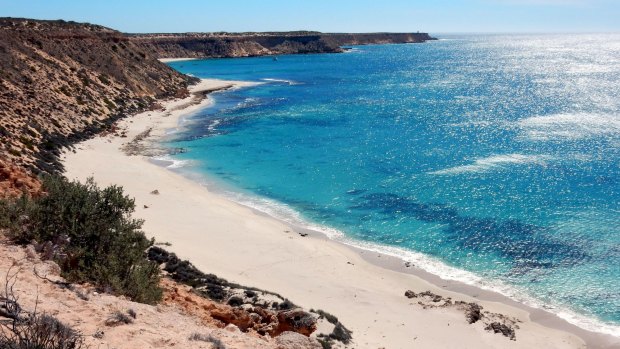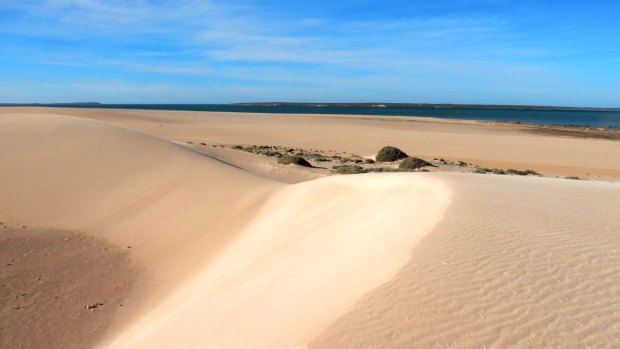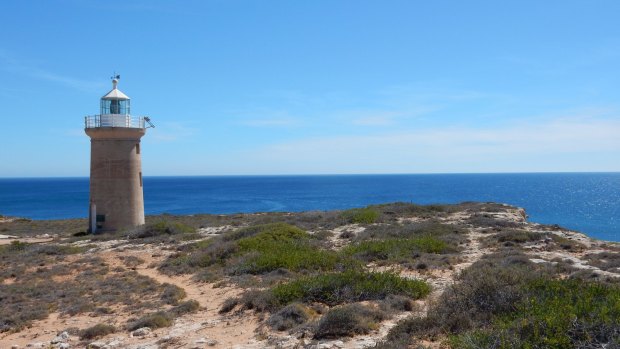This was published 9 years ago
Dirk Hartog Island, Western Australia: The place where Australia nearly became French
By David Whitley

Dirk Hartog Island's Turtle Bay.Credit: David Whitley
"He said it was buried under a small, shrub-like tree," says Kieran Wardle, owner of the Dirk Hartog Island Eco Lodge and inquisitive local expert on Louis Aleno de St Alouarn.
We look around. Below, there is the beach at Turtle Bay, a staggering, world-beating stretch of white sand where loggerhead turtles nest en masse. Everywhere else, as far as the eye can see and well beyond, are small shrub-like trees.
French explorer St Alouarn, it seems, didn't give the best instructions to find the bottle he buried. It contained two coins and piece of parchment claiming the country his men had just set foot on for France. But it would only be discovered 226 years later. By which stage, it was a bit late. The alternate reality whereby Australia became a French colony got washed away in a sequence of misfortune and neglect.

The sand dunes of Dirk Hartog IslandCredit: David Whitley
St Alouarn's ship, the Gros Ventre, arrived at Dirk Hartog Island in Western Australia on March 30th, 1772. It was part of an ill-fated expedition that had already seen the Gros Ventre separated from the flagship, and the mission's commander, which had long turned back for home. They were searching for "Gonneville Land", a continent believed to be in the same region of the globe as New Holland, the patchily charted southern land already discovered by the Dutch.
Being too ill to go ashore himself, St Alouarn sent his crew onto the island to explore and stake a claim. As far as the now-forgotten explorer was concerned, he had claimed everything to the east and north of that spot for France.
Unfortunately, St Alouarn never made it home. He became gravely ill in Java, and died in Mauritius. Word of his conquest got to France second hand, and France was too preoccupied with other affairs to follow up on it. The British snuck in ahead to settle on Australia's east coast with the First Fleet in 1788. And, when the French finally started showing a proper interest again in 1829, the British nipped in again to set up the Swan River Colony (now Perth) in the west.

Dirk Hartog Island's lighthouse.Credit: David Whitley
Despite the vast expanse of small, shrub-like trees, Kieran knows which one the bottle was buried under - he helped out the team that finally found it in 1998. The bottle was still there, the coins were still there, but the parchment proclaiming annexation had long gone. Whether a victim to the elements or pilfering, nobody knows.
"In retrospect," says Kieran. "The position should have been more obvious. Look where we are on the cliffs looking down at the beach – it's the smallest gradient. Of course they would have climbed up this way."
This isn't the heritage site that we've juddered along poorly-maintained dirt tracks for two-and-a-half hours to see, though.
Dirk Hartog Island has a special place in Australian history. 400 years ago, Dutch East India Company captain Dirk Hartog became the first European to indisputably set foot on Australian soil. On the 25th of October 1616, he left an engraved pewter plate at the northern tip of the island that now bears his name. Fellow Dutchman Willem Janszoon may have beaten him to Australian soil on Cape York in 1606, but Janszoon left no record behind.
That pewter plate is now in Amsterdam's Rijksmuseum (it was nabbed by a later Dutch explorer), but a commemorative post stands in the cleft in the rock where it once was. Nearby at Cape Inscription is the lighthouse that acts as one of the few human imprints on Western Australia's largest island.
The last stop, however, is more notable for what was taken away than what was left behind. On August 17th, 1699, English captain William Dampier came ashore at what's now called Dampier's Landing. He gathered up a few plants – all of which still grow on the island – and took them back to England. It was the first scientific collection made in Australia, and can still be seen at Oxford University.
From there, it's a long bumpy clatter back to the Lodge in the Landcruiser. The journey heads past machinery graveyards from the island's time as a pastoral station, eerie pink lakes along the coast and over huge Sahara-esque sand dunes. Rays flit in the clear waters, and the creatures that give Shark Bay its name scatter schools of fish.
The Lodge itself feels like it could be the last place surviving after the world has been wiped out by a nuclear holocaust; a remote country farmstead that just so happens to be staring out over turquoise waters. But, notably, the French tricolore flag has never flown above it.
Trip notes
MORE INFORMATION
GETTING THERE
Qantas and Virgin Australia fly to Perth from Sydney and Melbourne. From there, it's around a 10-hour drive to Dirk Hartog Island. 4WDs and advance barge bookings via the Lodge are essential. Otherwise, Skipper's Aviation flies to Shark Bay, and the Lodge offers a ferry service from Denham. See qantas.com.au, virginaustralia.com.au,
STAYING THERE
The Dirk Hartog Island Eco-Lodge offers a three night package in en-suite accommodation at the Homestead for $1,338 per person. This includes all meals, soft drinks and return transfers from Denham. See dirkhartogisland.com.
SEE + DO
The package also includes a full day 4WD trip to Cape Inscription and the other key historic sites, plus a half day trip to Surf Point in the island's south.
David Whitley was a guest of Tourism Western Australia (westernaustralia.com).
See also: The untouched Aussie islands home to an unspeakable horror
Sign up for the Traveller Deals newsletter
Get exclusive travel deals delivered straight to your inbox. Sign up now.